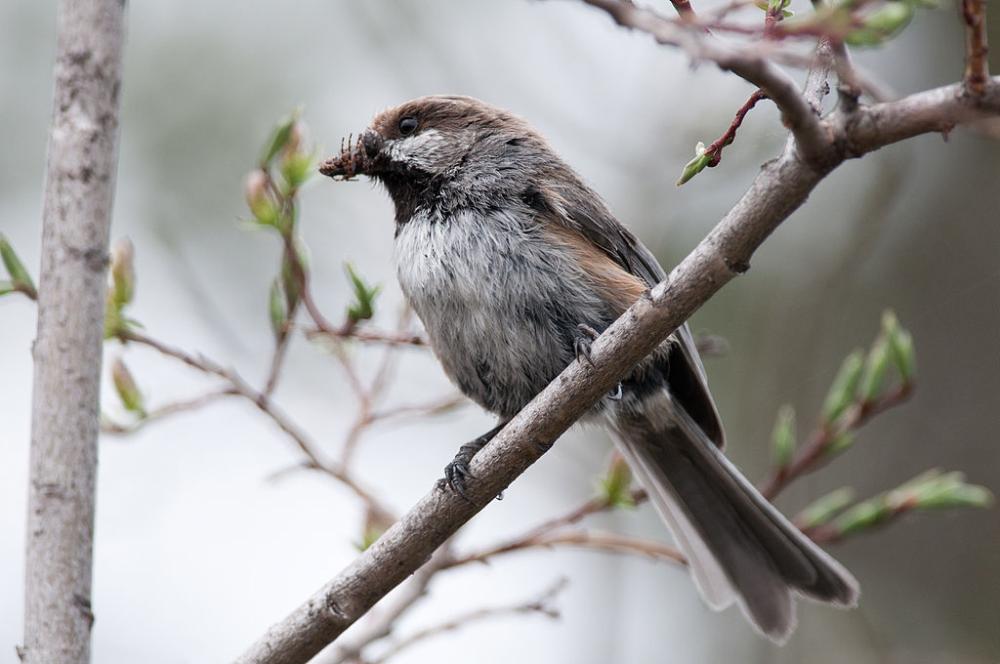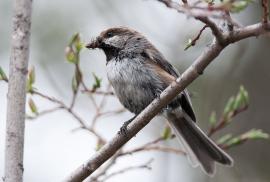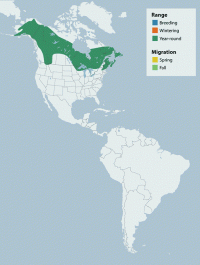Guide to Boreal Birds
This is an in-depth boreal species profile.
What is this?
This species is one of more than 30 birds selected for in-depth profiles. Find out why and see all selected boreal birds »
Overview
The Boreal Chickadee is worthy of its name. It is one of a very few passerine species with a range almost completely restricted to the boreal forest of Canada. It breeds from northern Alaska east to Labrador and Newfoundland, and south to northern edge of United States. Unlike the Black-capped Chickadee, this species spends most of its time in the interior of dense spruces, coming less readily to the tips of branches, and so it is much less easily observed. During late summer and early fall, when there is an abundance of caterpillars and seeds, Boreal Chickadees store food for winter among needles or under the bark of branches at a height that will be above the winter snow cover. This tame little bird is known by a variety of common names across its range, including: Tom-tit, Chick Chick, Fillady, Hudsonian Chickadee, Acadian Chickadee and Brown-capped Chickadee. Its closest relatives are two other species of "brown-capped" chickadees, the Siberian Tit (Parus cinctus) and the Chestnut-backed Chickadee (Parus rufencens). The distinctive "nasal" vocalizations of the Boreal Chickadee resemble those of a Black-capped Chickadee (Poecile atricapillus) suffering from a cold. Boreal Chickadee vocalizations are peculiar, however, in their lack of a whistled song.
Description
5-5 1/2" (13-14 cm). Similar to Black-capped Chickadee, but crown and back brown, flanks rufous.
Voice
A husky chick-a-dee-dee, lazier and more nasal than call of Black-capped.
Nesting
5-7 white eggs, lightly speckled with red-brown, in a cup of plant down, feathers, and moss in a natural cavity, often only a few feet from the ground.
Habitat
The Boreal Chickadee is a permanent resident of boreal forests. It occurs almost entirely in coniferous forests, but is found to a lesser extent in mixed woodlands. The forest habitats utilized by Boreal Chickadees are often wet, or at high elevations, generally composed of spruce (Picea sp.) and balsam fir (Abies Balsamea). This preference for spruce and fir forests results in patchy distribution of Boreal Chickadees in the southern limits of their range where forests are largely deciduous. The northern limit of this Chickadee's range coincides with the northern limit of white spruce (Picea glauca). Tree species appears to be more important for habitat selection than age of the forest, since Boreal Chickadees have been found to use both young and mature forests. During the breeding season, Boreal Chickadees tend to move to higher elevations if their range overlaps that of another chickadee species.
Range/Migration
Boreal Chickadees are permanent residents of the Boreal regions of North America. They are generally non-migratory and remain within their breeding range throughout the year. Occasionally irruptive movements or short-distance migrations will occur in parts of the range. These limited movements tend to be in southward directions and are thought to occur during severe food shortages. In certain mountainous regions the chickadees may descend to lower elevations.
During winter Boreal Chickadees usually form flocks of 4-8 birds but, will sometimes remain as a pair or an individual. These flocks sometimes combine with Black-capped Chickadees, Red-breasted Nuthatches, and Golden-crowned Kinglets during winter months.
Breeding
Breeding range of this species covers the entire boreal forest region including coniferous forests across Canada and as far north as Alaska. Boreal Chickadees breed in all Canadian provinces, excluding coastal regions of British Columbia, the extreme north, and the prairie regions of Alberta, Saskatchewan, and Manitoba. They have limited breeding range within the United States, extending only as far south as the northern edges of Maine, New Hampshire, Vermont, New York, Michigan, Wisconsin, Minnesota, Montana, Idaho, and Washington. Pair bonds are formed sometime during the winter flocking period and, in late April, the flocks usually disperse into these territorial pairs.
Nests are in tree cavities. The female does most of the construction by excavating holes in trees, finding natural openings, or using pre-existing nest cavities made by other species. The chickadees do not select a particular species of tree, but choose a snag with a hard outer layer and soft inner heartwood which permits easy excavation. The cavity forms the structure of the nest which is lined with soft materials including moss and hair. The clutch size ranges from 4-9 and varies across the geographic range of the species. The female incubates the brood while the male supplies her with food. The young are fed by both parents and remain with the parents for approximately 2 weeks after fledging.
Diet/Feeding Behavior
Boreal Chickadees feed principally on tree-inhabiting spiders, insects, pupae and eggs. They tend to be omnivorous and opportunistic supplementing this insectivorous diet with conifer seeds and occasionally fruit. Most of the foraging takes place in the middle and upper forest canopy. However, in the presence of Black -capped Chickadees they may shift their foraging sites further up the trees. Food items are usually gathered from the trunk and branches through gleaning, by hanging head down or hovering. Large insects may be held under a foot in order to remove the wings before consumption. While foraging in late summer and autumn, Boreal Chickadees regularly store food items for retrieval during the harsh winter months. Both insects and seeds are wedged into crevices in the bark and solidified in place with the bird's saliva. Storage sites tend to be on the undersides of branches to permit easy recovery when the branches are snow laden. During winter the chickadees will retrieve these cashed items while prying into crevices in the bark or searching branches and twigs for hibernating insects. Foraging is done in social groups except during the breeding season.
References
Bent, A. C. 1946. Life histories of North American jays, crows, and titmice. U.S. Natl. Mus. Bull. 191.
Erskine, A. J. 1977. Birds in boreal Canada: communities, densities, and adaptations. Can. Wildl. Ser. No. 30.
Erskine, A. J. 1992. Atlas of breeding birds of the Maritime Provinces. Nimbus Publ. and Nova Scotia Mus. Halifax, N.S.
Ficken, M.S., M.A. Mclaren, and J.P. Hailman. 1996. Boreal Chickadee(Parus hudsonicus). In The Birds of North America, No. 254 (A. Poole and f. Gill, eds.). The academy of natural sciences, Philadelphia, PA, and The American Ornithologists' Union, Washington, D.C.
Gill, F. B., A. M. Mostrom, and A. L. Mack. 1993. Speciation in North American chickadees: I. Patterns of mtDNA genetic divergence. Evolution 47:195-212.
Haftorn, S. 1974. Storage of surplus food by the Boreal Chickadee Parus hudsonicus in Alaska, with some records on the Mountain Chickadee Parus gambeli in Colorado. Ornis. Scand. 5:145-161.
McLaren, M. A. 1975. Breeding biology of the Boreal Chickadee. Wilson Bull. 87:344-354.
McLaren, M. A. 1976. Vocalizations of the Boreal Chickadee. Auk 93:451-463.
Credits
Birding content provided by National Wildlife Federation/eNature, with support from Ducks Unlimited/The Pew Charitable Trusts.





